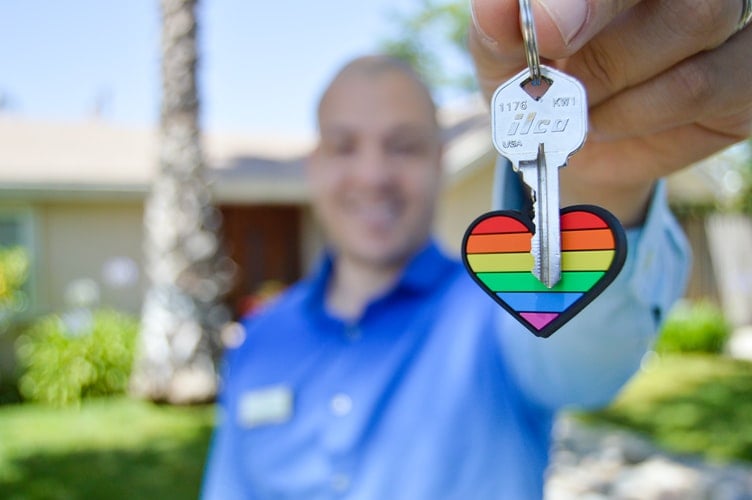Credit Tip Tuesday #36 - How to create a homeowner application package

Being a homeowner is something that most of us dream about. However, few individuals have a full understanding of how to buy a home in Canada in the 21st century. There are countless factors that play a part in buying a home in Canada, including: understanding the city you live in, developing a good credit score, understanding how interest works and much more.
While many of us have somewhat of an understanding about the basics of homeownership, like saving for a down payment and finding a good real estate agent, there are countless other elements to consider when looking for a home. That’s why we have broken down the fundamentals of preparing a homeowner package when looking for a new home. This package will include all the elements you need to provide listing agents when looking for a new home.
What Documents do I need for my application package?

At Plastk we understand that the real estate market is extremely competitive. In some cities, homes can be sold a few days after they hit the market. That’s why you must stay ahead of the crowd and ensure you’re prepared for what's to come when home hunting.
What should my application include
- A document showing your credit score (your credit report)
- Proof of employment
- A resume
- Statement of interest
- Complete a general application or offer letter
We will go into more detail into the elements you need in this article and offer advice for how to prepare this homeowner application package.
Preplanning
Research Neighborhoods and Homes

Before you begin on your home buying process, you must decide what neighborhoods you would like to live in. This process also involves looking into your wants and needs, to create a checklist. Some questions you can consider include:
- How many bedrooms do you like?
- Will you require parking?
- Would you like to live near a school?
- What amenities would you like in your neighborhood?
- Do I want to live in a:
- Rural location
- Urban location
- Suburban location
- Community near a body of water or mountain
- Gated community
- Somewhere else
You also may want to consider the type of home you’d want to live in.
 If you’re younger, or value living in downtown centers, you may consider buying a condo. Condos tend to be cheaper, are abundant in cities and offer great social amenities for individuals in their 20s and 30s. Condos usually have amenities like gyms, pools, rec centers and concierges. This can help to cut costs on some of your expenses. However, condos are usually much smaller than other properties. Furthermore, the only outdoor space usually available in condos are balconies.
If you’re younger, or value living in downtown centers, you may consider buying a condo. Condos tend to be cheaper, are abundant in cities and offer great social amenities for individuals in their 20s and 30s. Condos usually have amenities like gyms, pools, rec centers and concierges. This can help to cut costs on some of your expenses. However, condos are usually much smaller than other properties. Furthermore, the only outdoor space usually available in condos are balconies.
 If you enjoy the space a house offers, but want some of the amenities present in a condo, you may consider buying a townhouse. Townhouses are also common in cities, suburbs and small towns, but offer more space than traditional condos. Opposed to condos, many townhouses also have backyards or outdoor space. However, townhouses usually have homeowners associations or private neighborhood amenities, which makes them comparable to condos.
If you enjoy the space a house offers, but want some of the amenities present in a condo, you may consider buying a townhouse. Townhouses are also common in cities, suburbs and small towns, but offer more space than traditional condos. Opposed to condos, many townhouses also have backyards or outdoor space. However, townhouses usually have homeowners associations or private neighborhood amenities, which makes them comparable to condos.
A traditional house may be an option if you’re more concerned about size and space of your property, opposed to the amenities that come along with it. It is important to remember that if you’re looking for a house in a major city, like Toronto or Vancouver, you will have to pay significantly more than if you were to buy a townhouse or condo. Some of these properties may have amenities like pools, but this is far less common.
property, opposed to the amenities that come along with it. It is important to remember that if you’re looking for a house in a major city, like Toronto or Vancouver, you will have to pay significantly more than if you were to buy a townhouse or condo. Some of these properties may have amenities like pools, but this is far less common.
The final property type we can look into is buying plots of land. If you or your partner enjoy DIY projects, you may consider building your own home or hiring a custom home company. While this is a great option if you’re particular about the type of home you want, it may come with a higher price tag.
Now that you know what type of home you’d want to live in, you can consider location. You should be considering proximity to your place of work, your school or your children’s school and what you want in a neighborhood. Living outside of major cities may save you money on a home, but may cost you if you frequently travel into the city.
We suggest finding a list of 4 neighborhoods you like, to make your process easier. This gives you options for different neighborhoods and allows you to have extra security, in case one of the locations you look into doesn't have any homes for sale that fit your needs.
Saving for a Down Payment

Now that you know what type of home and location you’d like to live in, you can start saving for your home. We’ve written a blog that goes into more detail about saving for your first home, that you can reference for this step.
What are the basics of saving for my down payment?
- Save more than you think you’ll need for your down payment
- We recommend saving 5-10% more than you think you’ll need
- Look for ways you can save money in every aspect of your life
- Consider how much you can ACTUALLY afford to spend
Homeownership can be very exciting, but it isn’t the best thing for everyone. Before you decide to buy a home, make sure you consider the costs. Your monthly housing costs should not be more than about 35% of your gross monthly income. This includes costs such as mortgage payments and utilities.
While saving for a home is exciting, you must also consider if you will be able to afford your home after you pay your down payment.
Get a Real Estate Agent or Get to Know a Real Estate Company

Getting a real estate agent isn’t exclusive for those selling their homes. Real estate agents can act as liaisons between you and those selling their homes. Getting to know a real estate agent or real estate company can help you jump start the homebuying process, as these agents often hear about listings before they hit the market. Developing a positive relationship with listing agents can help you get the home of your dreams, as agents are more likely to look at offers from those they have a positive relationship with.
Finding a real estate agent that understands you, your wants and your needs can assist you in getting the home of your dreams and can take stress off of your home buying process.
While using a real estate agent isn't essential to buy a home, they can offer additional support and make your homebuying journey easier.
Preparing Your Package

Improving your credit score is essential to buying a home. In Canada you will likely need a score of 650 or greater, to qualify for the best homeowner loans. This is important because having a good rate on your loans will mean paying less in the long run. This can be the difference between paying $900,000 over the course of your mortgage or paying double this amount. We also recommend looking at rates at 2-3 different banks. This way you can ensure you get the best deal possible.

A soft inquiry, sometimes known as a soft credit check or soft credit check, happens when you or someone you authorize, like a potential employer or third party company, checks your credit report. They can also happen when a company such as a credit card issuer or mortgage lender checks your credit to pre approve you for an offer. The credit score Plastk offers is considered to be a soft check.
Soft inquiries don't impact your credit scores because they aren't attached to a specific application for credit. This is great for a credit application package, as it can help you gain insight into steps you’ll need to take to improve your credit and give your lender an idea of what loan rates you’ll likely qualify for. Credit scoring models generate your credit score by analyzing the information in your credit report. Soft inquiries don't have any impact on your credit scores.
Hard Credit Check

Hard inquiries, also known as “hard pulls” or “hard credit checks, generally occur when a financial institution, such as a lender or credit card issuer, checks your credit when making a lending decision. They commonly take place when you apply for a mortgage, loan or credit card, and you typically have to authorize them.
A hard inquiry could lower your scores by a few points, or it may have a negative effect on your scores. In most cases, a single hard inquiry is unlikely to play a huge role in whether you’re approved for a new card or loan. The damage to your credit scores usually decreases or disappears even before the inquiry drops off your credit reports for good. You will likely need to get this done when you are officially applying for a mortgage. However, this is usually not needed if you are just inquiring about rates.
Common hard inquiries
- Mortgage applications
- Car loan applications
- SOME Credit card applications
- Student loan applications
- Personal loan applications
- Apartment rental applications
Common soft inquiries
- Checking your credit score on Plastk.ca
- “Prequalified” credit card offers - like Plastk!
- “Prequalified” insurance quotes
- Employment verification (i.e., background check)
Check your credit score for FREE with Plastk, and save your credit report as a PDF. This will be the first element of your application package.
Proof of Employment
 The next step is getting a proof of employment letter. This shows the listing agent that you have a steady income to pay for the home and have security funds readily available. You can obtain this by asking your manager to write you a letter, contacting the HR department at your workplace to write you a letter or printing a copy of your signed offer letter.
The next step is getting a proof of employment letter. This shows the listing agent that you have a steady income to pay for the home and have security funds readily available. You can obtain this by asking your manager to write you a letter, contacting the HR department at your workplace to write you a letter or printing a copy of your signed offer letter.
Resume
This is a personal touch you can add to your application. Your resume will include your contact information and give the listing agent some insight into the type of person you are. This can help them see more information about how trustworthy you are and show your qualifications as a working professional. When buying a home it is important to be personable with the person who is selling the house you wish to buy. This can influence their decision to accept your offer, rather than another individual.
Statement of Interest

If you’ve ever been job hunting, you’ll know that cover letters can make or break your ability to make it to the next step in the hiring process. Homeownership is very similar. You should write a customizable statement of interest, that you can tweak slightly for every property you are interested in. This not only shows your interest in the property, but can help the real estate agent understand your situation.
Things to include in this:
- Name, profession and age
- A few personal sentences about you
- What you like about the neighborhood
- What you like about the house
- Why you want to live in the house
- What homeownership means to you
Try to include as many personal details about yourself and the house as you can. This shows interest and lets the selling team know that you are serious about the property.
Complete a General Offer Letter

When you’ve found the home you want to buy, it’s time to make an offer to the seller. While most sellers have slightly different types of application and offer agreements, filling out a general application further shows your interest in owning a home.
Your offer must include:
- your legal name, the name of the seller and the address of the property
- the amount you’re offering to pay (the purchase price) and the amount of your deposit
- any extra items you want included in the purchase (for example, window coverings, new appliances)
- the date you want to take possession (“closing day”)
- a request for a current land survey
- the date the offer expires
- any other conditions that must be met before the contract is finalized (for example, a home inspection)
- You should expect to negotiate.
This website: Offers two general forms you can fill out for this step of the process.
Now that you have all the basic elements ready for your application package, what’s next?
In the world of Covid, you’ll likely need to have two versions of this package. One for locations where touring in person is not an option and the other for homes you can visit in person. Although every province is in a different stage of their reopening plans, it is wise to have both options available. This makes the process easier for you and your real estate agent.
A virtual copy
Once all these documents are ready on your computer, you can create a locked zip file. This will allow you to put files of any size into a folder, and secure it with a password. This can offer you extra protection and allow the seller to see your application with ease.
A physical copy
This application package copy is very simple. All you need to do is print multiple copies of your application, and put copies of each file into a laminated folder. You can purchase these at any discount or office supply store. This allows sellers to look at your application with you and gain insight into your application while you are still with them.

Now that you have all these documents printed, you're ready to apply for your first home! We wish you the best of luck on your homeowner journey.
All these steps can help you in your journey towards homeownership. Have you recently purchased a home? If so, let us know what tips you learned in your process towards homeownership!
Disclaimer: The content provided on the Plastk Financial Inc. Blog is information to help Canadians become financially literate and learn about credit. Plastk is not responsible for building or ruining an individual's credit score or credit rating. It is neither tax nor legal advice, is not intended to be relied upon as a forecast, research or investment advice, and is not a recommendation, offer or solicitation to buy or sell any securities or to adopt any investment strategy. Tax, investment, credit inquiries, and all other decisions should be made, as appropriate, only with guidance from a qualified professional.
*Visa International and Digital Commerce Bank do not provide any of the services or benefits related to the Plastk rewards program. The terms and conditions applicable to these services or benefits are contained in the agreement between you and Plastk Financial & Rewards Inc.All credit Issued by Plastk Financial & Rewards Inc. This card is owned and issued by Digital Commerce Bank, pursuant to license from Visa International. Use of the card is governed by the agreement under which it is issued. The Visa Brand is a registered trademark of *Visa International.


